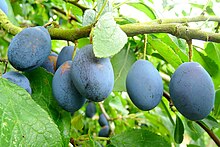Damson
| Damson | |
|---|---|
 |
|
| Ripe damsons | |
| Scientific classification | |
| Kingdom: | Plantae |
| (unranked): | Angiosperms |
| (unranked): | Eudicots |
| (unranked): | Rosids |
| Order: | Rosales |
| Family: | Rosaceae |
| Genus: | Prunus |
| Subgenus: | P. subg. Prunus |
| Section: | P. sect. Prunus |
| Species: | P. domestica |
| Subspecies: | P. d. subsp. insititia |
| Trinomial name | |
|
Prunus domestica subsp. insititia (L.) C.K.Schneid. |
|
The damson (/ˈdæmzən/) or damson plum (Prunus domestica subsp. insititia, or sometimes Prunus insititia), also archaically called the "damascene" is an edible drupaceous fruit, a subspecies of the plum tree. Varieties of insititia are found across Europe, but the name "damson" is derived from and most commonly applied to forms which are native to Great Britain. Damsons are relatively small plum-like fruit with a distinctive, somewhat astringent taste, and are widely used for culinary purposes, particularly in fruit preserves or jam.
In South and Southeast Asia, the term "damson plum" sometimes refers to Jambul, the fruit from a tree in the Myrtaceae family. The name "mountain damson" or "bitter damson" was also formerly applied in Jamaica to the tree Simarouba amara.
The name damson comes from Middle English damascene, damesene, damasin, damsin, and ultimately from the Latin (prunum) damascenum, "plum of Damascus". One commonly stated theory is that damsons were first cultivated in antiquity in the area around the ancient city of Damascus, capital of modern-day Syria, and were introduced into England by the Romans. The historical link between the Roman-era damascenum and the north and west European damson is rather tenuous despite the adoption of the older name. The damascenum described by Roman and Greek authors of late antiquity has more of the character of a sweet dessert plum, not fitting well to the damson plum. Remnants of damsons are sometimes found during archaeological digs of ancient Roman camps across England, and they have clearly been cultivated, and consumed, for centuries. Damson stones have been found in an excavation in Hungate, York, and dated to the late period of Anglo-Saxon England.
...
Wikipedia
